Kurta
A kurta (Hindi: कुर्ता, Bengali: পাঞ্জাবী, Punjabi: ਕੁੜਤਾ, Urdu: كُرتا pronounced [ˈkʊrt̪aː]) is an upper garment for men and women, originating in the Indian subcontinent, with regional variations of form.[1]
Etymology
The word kurta is a borrowing from Urdu, Hindustani,[2] originally from either Sanskrit kuratu/kurtaka[3] or Persian (literally, "a collarless shirt").[4] It was first used in English in the 20th century.[5] A kurta worn by females is called a kurti.
Distribution
The kurta is traditionally worn in Pakistan, Bangladesh and India and is also popular in Nepal[6] and Sri Lanka.[7][8][9] The kurta is worn with a Dhoti, Paijama, Shalwar, lungi or jeans. The kurta is similar to the perahan worn in Afghanistan, the phiran of Kashmir and the daura of Nepal.
Styles
The straight cut kurta is a loose shirt falling either just above or somewhere below the knees of the wearer, and is traditionally worn by men. However, women do also wear the straight cut kurta or its shorter version, the kurti. They were traditionally worn with loose-fitting paijama (kurta-paijama), loose-fitting shalwars, semi-tight (loose from the waist to the knees, and tight from the calves to the ankles) churidars, or wrapped-around dhotis;[5] but are now also worn with jeans.[10] Kurtas are worn both as casual everyday wear and as formal dress.
Imported straight cut kurtas were fashionable in the United States in the 1960s and 1970s, as an element of hippie fashion, fell from favor briefly, and are now again fashionable. South Asian women may also wear this Western adaptation of South Asian fashion.
Some styles, button or are tied at the shoulder seam and have plackets rather than slits. The opening may be centered on the chest, or positioned off center.
Traditional forms of kurta do not have collar. Modern variants may feature stand-up collars of the type known to tailors and seamstresses as "mandarin" collars. These are the same sort of collars seen on achkans, sherwanis, and Nehru jackets.
Kali kurta
A kali or kalidar kurta is similar to a frock and has many panels.[11] The kalidar kurta is made up of several geometrical pieces. It has two rectangular central panels in the back and the front.[12] The kali kurta is worn by men[13] and women.
Bhopali kurta
The Bhopali kurta (taking its name from Bhopal) is a loose kurta with pleats at the waist flowing like a skirt reaching midway between the knees and the ankles.[14] It is worn with a straight pajamma.[15] The Bhopali kurta was popular with the local royal families and is believed to have been adopted from the dress of Turkey by Sultan Jehan Begum[16] who reigned between 1901 and 1926 A.D.[17]
Hyderabadi kurta
The Hyderabadi kurta is named after the former royal state of Hyderabad and is a short top which sits around the waist, with a keyhole neck opening. It was popular with the local royal households.[18][19] Traditionally, the Hyderabadi kurta was of white material[20] but modern versions can be of any colour. Over the kurta, some versions have net material the combination of which is called jaali karga, worn by men and women.[21]
Lucknowi kurta
The traditional Lucknowi kurta is can either be short[22] or long using as much as 12 yards of cloth.[23] The traditional Lucknowi kurta styles have an overlapping panel.[24] However, the term Lucknowi kurta now applies to the straight cut kurta embroidered using local Chikan embroidery.
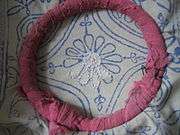 Chikan embroidery, Lucknow
Chikan embroidery, Lucknow
Dogri kurta
The Dogri men's kurta is open at the front but flares out at the hips.
 Men and boys wearing a variation of the suthan and Dogri kurta
Men and boys wearing a variation of the suthan and Dogri kurta
Overlapping kurta
The overlapping kurta does not flow straight but is similar to a mini gown.
 Man on the right in overlapping kurta 1848.
Man on the right in overlapping kurta 1848..jpg) Mrinal Kulkarni in an overlapping kurta
Mrinal Kulkarni in an overlapping kurta
Straight cut kurta
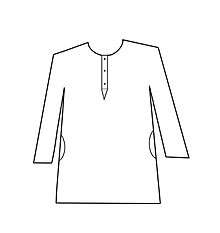
The straight cut traditional kurta (known as Panjabi in West Bengal, Bangladesh [25] (Bengali: পাঞ্জাবী) and Assam[26] (Assamese: পনজাবি) and as Punjabi[27] in Madhya Pradesh[28] and Gujarat)[29] or simply Punjabi kurta[30][31][32] consists of rectangular fabric pieces with perhaps a few gusset inserts, and is cut so as to leave no wasted fabric. The cut is usually simple, although decorative treatments can be elaborate.
The sleeves of a traditional kurta fall straight to the wrist; they do not narrow, as do many Western-cut sleeves. Sleeves are not cuffed, just hemmed and decorated.
The front and back pieces of a simple kurta are also rectangular. The side seams are left open for 6-12 inches above the hem, which gives the wearer some ease of movement.
The kurta usually opens in the front and the front opening is often a hemmed slit in the fabric, buttoned at the top. The traditional straight cut kurta does not have a collar but modern versions do.
The use of side slits in the straight cut kurta can be traced to the 11th century C.E.[33] female kurtaka worn in parts of north India and was a short shirt, with sleeves extending from the shoulders, to the middle of the body, and had slashes on the left and the right sides.[34] This is the same as the modern straight cut kurta which has side slits and worn by women in Punjab.[35]
Regional embroidery, prints and designs
Straight cut kurtas using regional embroidery designs are labelled according to the region from where the patterns originate.
Multani kurta
The Multani kurta is crocheted using designs of Multan (Punjab, Pakistan).[36] Local Ajrak prints are also used. The Multani kurta is also known as the Saraiki kurta.
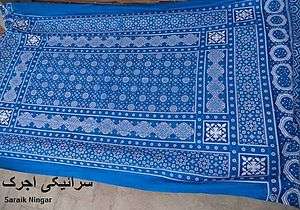 Saraiki Ajrak
Saraiki Ajrak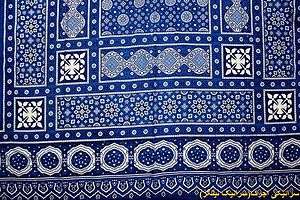 Saraiki Ajrak
Saraiki Ajrak Saraiki kurta
Saraiki kurta
Punjabi phulkari kurta
A Phulkari kurta is emroidered using the Phulkari embroidery of the Punjab region.[37]
 Punjabi straight cut kurta Ferozepur 1845
Punjabi straight cut kurta Ferozepur 1845%2C_Punjab%2C_early_20th_century%2C_cotton%2C_silk_and_embroidery%2C_Honolulu_Academy_of_Arts.jpg) 'Phulkari' (bridal shawl), Punjab, early 20th century, cotton, silk and embroidery, Honolulu Academy of Arts
'Phulkari' (bridal shawl), Punjab, early 20th century, cotton, silk and embroidery, Honolulu Academy of Arts- Phulkari from Punjab, India, 20th century, khadi, silk, plain weave, embroidery, Honolulu Museum of Art
 Punjabi woman in short Punjabi kurta 1874
Punjabi woman in short Punjabi kurta 1874
Punjabi bandhani kurta
Bandhani tye-dyeing is popular in the Cholistan desert[38] area of the Punjab region. Bandhani patterns are used on kurtas.
- Rohi (Cholistan) woman's bandhani dress (Punjab, Pakistan)
Muktsari kurta
The traditional Punjabi kurta of the Punjab region is wide and falls to the knees[39] and is cut straight.[40] The modern version of the regional kurta is the Mukatsari kurta which originates from Muktsar in Punjab. This modern Punjabi kurta is famous for its slim fitting cuts and smart fit designs. It is very popular among young politicians.[41]
Delhi kurta
Styles of kurta peculiar to Delhi include the wooden beaded kurta and a kurta heavily laden with embroidery.[42]
Sindhi kurta
The Sindhi kurta is the traditional straight cut variety but uses local patterns to embroider the garment and also makes use of mirrors. The local art of bandhani (creating patterned textiles by resisting parts of a fabric by tying knots on it before it is dyed) is utilised which is believed to have originated in Sindh and spread to Gujarat via Rajasthan[43] and is also practiced in the Punjab region. Sindhi kurtas are also made out of heavy local material called rilli and the kurtas are often called rilli kurtas.[44] Ajrak prints are also used.
 Sindhi hat with Ajrak designs. Scarf with bandhani prints
Sindhi hat with Ajrak designs. Scarf with bandhani prints Ajrak
Ajrak- Rilli material
Assamese Panjabi
The Assamese Panjabi is worn with a scarf (Gamosa) using local prints.
- Gamosa print
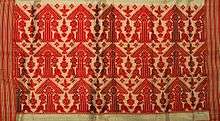 Gamosa pari
Gamosa pari Man wearing a Panjabi with a Gamosa
Man wearing a Panjabi with a Gamosa Gamosa
Gamosa
Bengali Panjabi
The Bengali Panjabi utilises local embroidery traditions. Kantha embroidery means patched cloth and is the regional style of West Bengal and Bangladesh.[45] Kantha is also traditional in Odisha. The other variety of embroidery from West Bengal and Bangladesh is the Nakshi kantha.
_LACMA_AC1994.131.1.jpg) Kantha (Quilt) LACMA AC1994.131.1
Kantha (Quilt) LACMA AC1994.131.1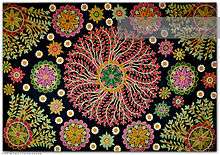 Modern Nakshi kantha
Modern Nakshi kantha Scholar in kurta, East Bengal (Bangladesh), 1860
Scholar in kurta, East Bengal (Bangladesh), 1860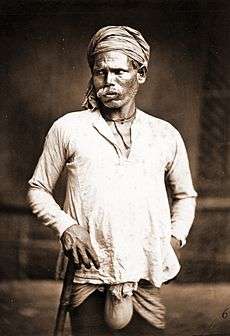 Man in short kurta, East Bengal (Bangladesh), 1860.
Man in short kurta, East Bengal (Bangladesh), 1860.
Photo gallery
 A modern shin-length embroidered silk kurta
A modern shin-length embroidered silk kurta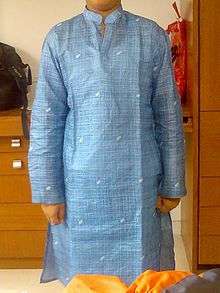 A blue khadi kurta
A blue khadi kurta An Indian child in kurta
An Indian child in kurta Pakistan Frontier Constabulary soldiers wearing kurtas at Torkham border crossing gate.
Pakistan Frontier Constabulary soldiers wearing kurtas at Torkham border crossing gate. Indian Army 15th Sikh Regiment, wearing kurtas, arrives in Marseille, France on their way to fight the Germans during the First World War
Indian Army 15th Sikh Regiment, wearing kurtas, arrives in Marseille, France on their way to fight the Germans during the First World War Assamese Gamosa and Panjabi
Assamese Gamosa and Panjabi- Kurta, India, 20th century, cotton blend - Saint Ignatius Church, San Francisco, CA - DSC02637
- Man in Dhoti Kurta
 Bhangra Dance performers in Punjab wearing Kurta and Tehmat.
Bhangra Dance performers in Punjab wearing Kurta and Tehmat. Man in blue kurta
Man in blue kurta- Statues of women in kurta
- kurta
 Pahari (Hill) women in kurtas, Kashmir, 1890.
Pahari (Hill) women in kurtas, Kashmir, 1890.
Jeans and straight cut kurta
Kurtas are often worn with jeans.[10] Women sometimes wear kurtas as blouses, usually over jeans pants.[46] Jeans are sometimes preferred over pajamas or leggings as they are more durable for rough use. Most colours kurtas match with blue jeans.[47] In 2014, an Indian family court in Mumbai ruled that a husband objecting to his wife wearing a kurta and jeans and forcing her to wear a sari amounts to cruelty inflicted by the husband and can be a ground to seek divorce.[48] The wife was thus granted a divorce on the ground of cruelty as defined under section 27(1)(d) of Special Marriage Act, 1954.[48]
Leggings and ladies straight cut kurta
Ladies kurtas/blouses, along with leggings are most popular in India, Pakistan, and the South Asian community in Singapore and Malaysia.[49]
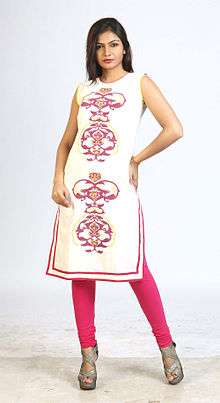 Hand crafted long ladies kurta with pink leggings.
Hand crafted long ladies kurta with pink leggings. White printed ladies kurta with pink leggings.
White printed ladies kurta with pink leggings.
Kurti
In modern usage, a short kurta is referred to as the kurti. However, traditionally, the kurti refers to waist coats,[50] jackets and blouses[51] which sit above the waist without side slits, and are believed to have descended from the tunic of the Shunga period (2nd century B.C.).[52] Kurtis are typically much shorter than the traditional garments and made with a lighter materials, like those used in sewing kameez.
Material
Kurtas worn in the summer months are usually made of thin silk or cotton fabrics; winter season kurtas are made of thicker fabric such as wool or Khadi silk, a thick, coarse, handspun and handwoven silk that may be mixed with other fibers. A very common fabric for kurta pajama is linen, or linen cotton mix ideal for both summers and winters.
Kurtas are typically fastened with tasselled ties, cloth balls and loops, or buttons. Buttons are often wood or plastic. Kurtas worn on formal occasions might feature decorative metal buttons, which are not sewn to the fabric, but, like cufflinks, are fastened into the cloth when needed. Such buttons can be decorated with jewels, enameling, and other traditional jewelers' techniques.
Decoration
South Asian tailors command a vast repertoire of methods, traditional and modern, for decorating fabric. It is likely that all of them have been used, at one time or another, to decorate kurtas. However, the most common decoration is embroidery. Many light summer kurtas feature Chikan embroidery, a speciality of Lucknow, around the hems and front opening. This embroidery is typically executed on light, semi-transparent fabric in a matching thread. The effect is ornate but subtle.
 Close up of Chikan embroidery and wood (sandalwood) cuff links style buttons on kurta
Close up of Chikan embroidery and wood (sandalwood) cuff links style buttons on kurta Close up of knot-and-loop button for a "side open" Kurta
Close up of knot-and-loop button for a "side open" Kurta Side-opening Chikan kurta with semi-precious-stone cuff-links-style buttons
Side-opening Chikan kurta with semi-precious-stone cuff-links-style buttons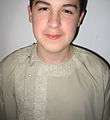 Close up of semi-precious-stone cuff-links-style buttons
Close up of semi-precious-stone cuff-links-style buttons A traditional cotton Chikan embroidery kurta with grandfather collar and wooden cuff-links-style buttons.
A traditional cotton Chikan embroidery kurta with grandfather collar and wooden cuff-links-style buttons. A traditional muslin "side-open" kurta with knot-and-loop in place of buttons.
A traditional muslin "side-open" kurta with knot-and-loop in place of buttons. modern Indian woman in a Kurta.
modern Indian woman in a Kurta.
See also
References
- ↑ Kumar, Ritu (2006) Costumes and textiles of royal India
- ↑ Merriam Webster: Kurta
- ↑ Ghurye, Govind (1966). Indian Costume. Mumbai: Popular Prakashan. p. 118. ISBN 81-7154-403-7. Retrieved 2015-05-12.
A Chinese dictionary of the latter half of the 8th century A.D. lists 'kuratu' as the Sanskrit equivalent of a Chinese word which means skirt. And Al-Biruni later noted that females in North India wore 'kurtaka', which was a short skirt extending from the shoulders to the middle of the body and had sleeves.
line feed character in|quote=at position 108 (help) - ↑ McGregor, R. S. (ed.). 1993. The Oxford Hindi-English Dictionary. Oxford University Press. 1083 pages. ISBN 0-19-563846-8.
- 1 2 Oxford English Dictionary, Second Edition. 1989. The first use is attributed to W.G. Lawrence in T. E. Lawrence, Home Letters, 1913, "Me in a dhoti khurta, White Indian clothes."
- ↑ Tulasī Rāma Vaidya, Triratna Mānandhara, Shankar Lal Joshi (1993) Social history of Nepal
- ↑ Urmila Phadnis (1973) Sri Lanka
- ↑ Nira Wickramasinghe (2015) Sri Lanka in the Modern Age: A HIstory
- ↑ Kemper, Steven (2001) Buying and Believing: Sri Lankan Advertising and Consumers in a Transnational World. The straight cut kurta was adopted during 1930s - 1940s but is only worn by certain men on certain occasions.
- 1 2 "Regal chic", The Telegraphk, Calcutta, April 24, 2004. Quote: "The first sequence was a range of traditional saris in silk and cotton, moving on to kurtis and jeans and short kurtas in silk and georgette."
- ↑ Karampuri, Aradhana (2005) Punjabi Dress Drafting and Cutting
- ↑ Bhandari, Vandana (2005) Costume, textiles and jewellery of India: traditions in Rajasthan
- ↑ Rashtriya Sahara, Volume 2, Issue 2 1991
- ↑ Jamila Brij Bhushan (1958) The Costumes and Textiles of India
- ↑ Illustrated Weekly of Pakistan, Volume 20, Issues 27-39 (1968)
- ↑ Cine Blitz, Volume 29, Issue 1 (2003)
- ↑ S.R. Bakshi And O.P. Ralha (2008) Madhya Pradesh Through the Ages
- ↑ Kumar, Ritu (2006) Costumes and textiles of royal India
- ↑ Mohan Lal Nigam, Anupama Bhatnagar (1997) Romance of Hyderabad Culture
- ↑ Javed, Arifa Kulsoom (1990) Muslim society in transition
- ↑ Aslan, Reza (2011) Tablet & Pen: Literary Landscapes from the Modern Middle East (Words Without Borders): Literary Landscapes from the Modern Middle East
- ↑ Mukherji, P. C. The Pictorial Lucknow (1883)
- ↑ Ravi Bhatt. The Life and Times of the Nawabs of Lucknow
- ↑ Karampuri, Aradhana (2005) Punjabi Dress Drafting and Cutting
- ↑ Ishaq, Muhammad (1977) Bangladesh District Gazetteers: Faridpur, Volumes 7-8
- ↑ Ghosh, G.K. (1992) Tribals and Their Culture in Assam, Meghalaya, and Mizoram, Volume 3
- ↑ Oxford Dictionary of English "(Punjabi) a long kurta (loose collarless shirt)"
- ↑ Madhya Pradesh District Gazetteers: Hoshangabad (1827)
- ↑ Gazetteers: Vadodara District 1979
- ↑ The March of India, Volume 13 1961
- ↑ Kashyap, Pooja (10.08.2010) The Times of India. Eastern India's first revolving restaurant opens in Patna
- ↑ Gupta, Shilpy (2009) Human Rights Among Indian Populations: Knowledge, Awareness and Practice
- ↑ Ghurye, Govind Sadashiv (1966) Indian Costume
- ↑ Yadava,Ganga Prasad (1982) Dhanapāla and His Times: A Socio-cultural Study Based Upon His Works
- ↑ Sharma, Brij Narain (1966) Social life in Northern India, A.D. 600-1000
- ↑ Official Journal of the European Communities: Legislation, Volume 30, Issues 248-256 (1987)
- ↑ Naik, Shailaja D. (1996( Traditional Embroideries of India
- ↑ Nasreen Askari, Liz Arthur, Paisley Museum and Art Galleries Merrell Holberton, (1999) Uncut cloth
- ↑ Punjab District Gazetteers: Attock district, 1930. Printed 1932
- ↑ Asoke Kumar Bhattacharyya, Pradip Kumar Sengupta (1991) Foundations of Indian Musicology: Perspectives in the Philosophy of Art and Culture
- ↑ Puneet Pal Singh Gill (04.01.2012) The Chandigarh Tribune Muktsari-style kurta pyjama a fad
- ↑ United States Treaties and Other International Agreements, Volume 21, Part 3 (1971)
- ↑ Ranjan, Aditi and Ranjan, M. P. (2009) Handmade in India: A Geographic Encyclopedia of Indian Handicrafts
- ↑ Pakistan Exports, Volume 28 (1977)
- ↑ Naik, Shailaja D. (1996) Traditional Embroideries of India
- ↑ [Yet, jeans are among the most comfortable outfits as they can go with just about anything, a short top or even a kurta.]
- ↑
- 1 2 PTI (2014-06-28). "Wife's jeans ban is grounds for divorce, India court rules". GulfNews.com. Retrieved 2015-10-28.
- ↑ Jaime Koh, Stephanie Ho Ph.D (2009) Culture and Customs of Singapore and Malaysia
- ↑ Forbes, Duncan (1861) A smaller Hindustani and English dictionary
- ↑ Bahri, Hardev (2006) Advanced learner's Hindi English Dictionary
- ↑ Panjab University Research Bulletin: Arts, Volume 13, Issue 1 - Volume 14, Issue (1982)
Notes
| Wikimedia Commons has media related to Kurtas. |
- Tarlo, Emma (1996): Clothing Matters: Dress and Identity in India. Chicago: University of Chicago Press. 382 pages. ISBN 0-226-78976-4.
- Bhandari, Vandana (2004): Costumes, Textiles, and Jewellery of India. Mercury Books. 192 pages. ISBN 1-904668-89-5.